child seat PEUGEOT 308 2011 Owners Manual
[x] Cancel search | Manufacturer: PEUGEOT, Model Year: 2011, Model line: 308, Model: PEUGEOT 308 2011Pages: 328, PDF Size: 62.67 MB
Page 4 of 328
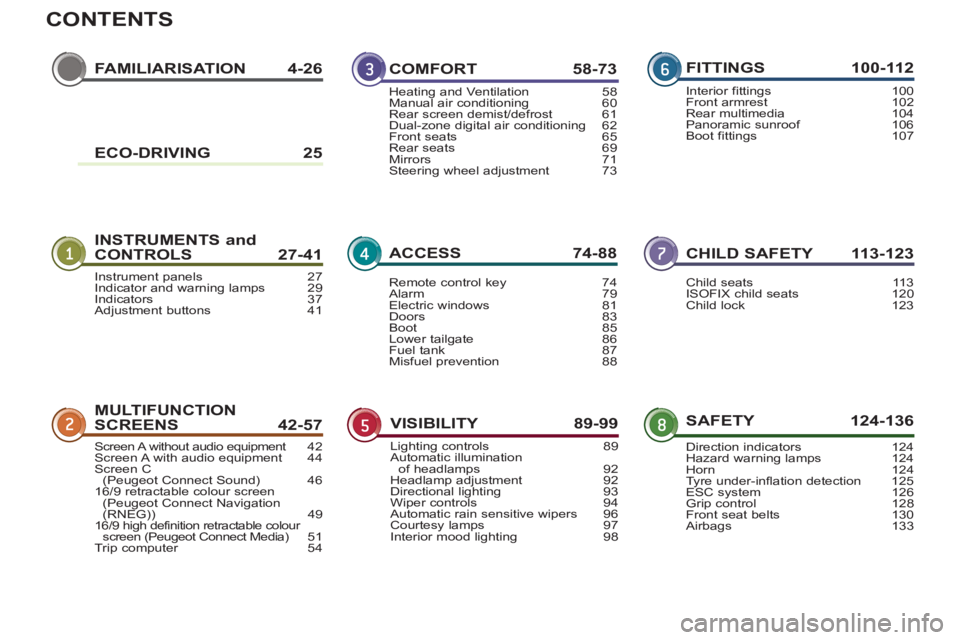
CONTENTS
FAMILIARISATION 4-26
INSTRUMENTS and
CONTROLS 27-41CHILD SAFETY 113-123
MULTIFUNCTION
SCREENS 42-57SAFETY 124-136 COMFORT 58-73
ACCESS 74-88
VISIBILITY 89-99FITTINGS 100-112
Instrument panels 27
Indicator and warning lamps 29
Indicators 37
Adjustment buttons 41Child seats 113
ISOFIX child seats 120
Child lock 123
Screen A without audio equipment 42
Screen A with audio equipment 44
Screen C
(Peugeot Connect Sound) 46
16/9 retractable colour screen
(Peugeot Connect Navigation
(RNEG)) 49
16/9 high definition retractable colour
screen (Peugeot Connect Media) 51
Trip computer 54Direction indicators 124
Hazard warning lamps 124
Horn 124
Tyre under-inflation detection 125
ESC system 126
Grip control 128
Front seat belts 130
Airbags 133 Heating and Ventilation 58
Manual air conditioning 60
Rear screen demist/defrost 61
Dual-zone digital air conditioning 62
Front seats 65
Rear seats 69
Mirrors 71
Steering wheel adjustment 73
Remote control key 74
Alarm 79
Electric windows 81
Doors 83
Boot 85
Lower tailgate 86
Fuel tank 87
Misfuel prevention 88
Lighting controls 89
Automatic illumination
of headlamps 92
Headlamp adjustment 92
Directional lighting 93
Wiper controls 94
Automatic rain sensitive wipers 96
Courtesy lamps 97
Interior mood lighting 98Interior fittings 100
Front armrest 102
Rear multimedia 104
Panoramic sunroof 106
Boot fittings 107
ECO-DRIVING 25
Page 19 of 328
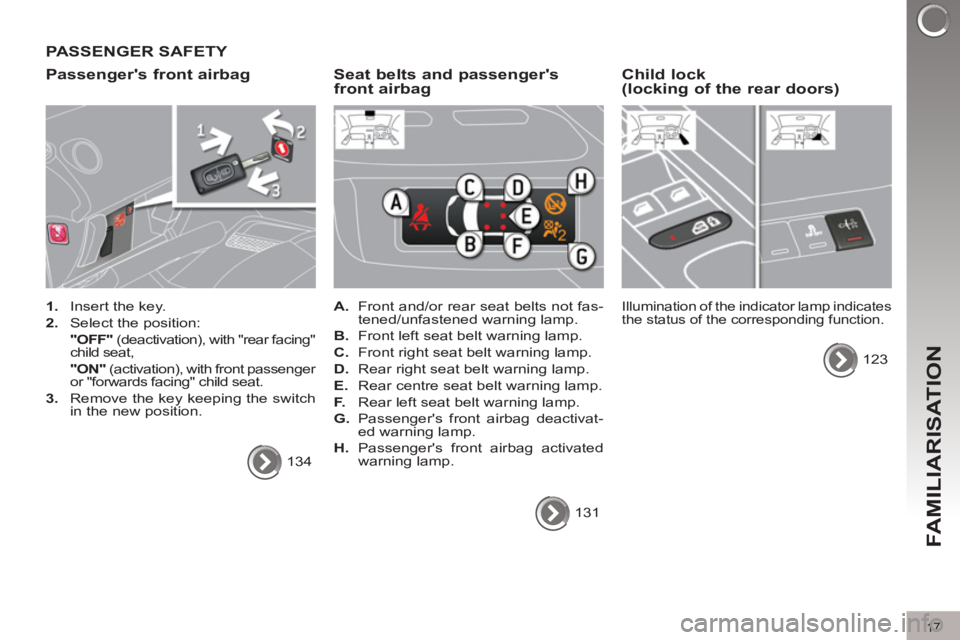
17
FAMILIARISATION
PASSENGER SAFETY
Passenger's front airbag
1.
Insert the key.
2.
Select the position:
"OFF"
(deactivation), with "rear facing"
child seat,
"ON"
(activation), with front passenger
or "forwards facing" child seat.
3.
Remove the key keeping the switch
in the new position.
134
Seat belts and passenger's
front airbag
A.
Front and/or rear seat belts not fas-
tened/unfastened warning lamp.
B.
Front left seat belt warning lamp.
C.
Front right seat belt warning lamp.
D.
Rear right seat belt warning lamp.
E.
Rear centre seat belt warning lamp.
F.
Rear left seat belt warning lamp.
G.
Passenger's front airbag deactivat-
ed warning lamp.
H.
Passenger's front airbag activated
warning lamp.
131
Child lock
(locking of the rear doors)
Illumination of the indicator lamp indicates
the status of the corresponding function.
123
Page 34 of 328
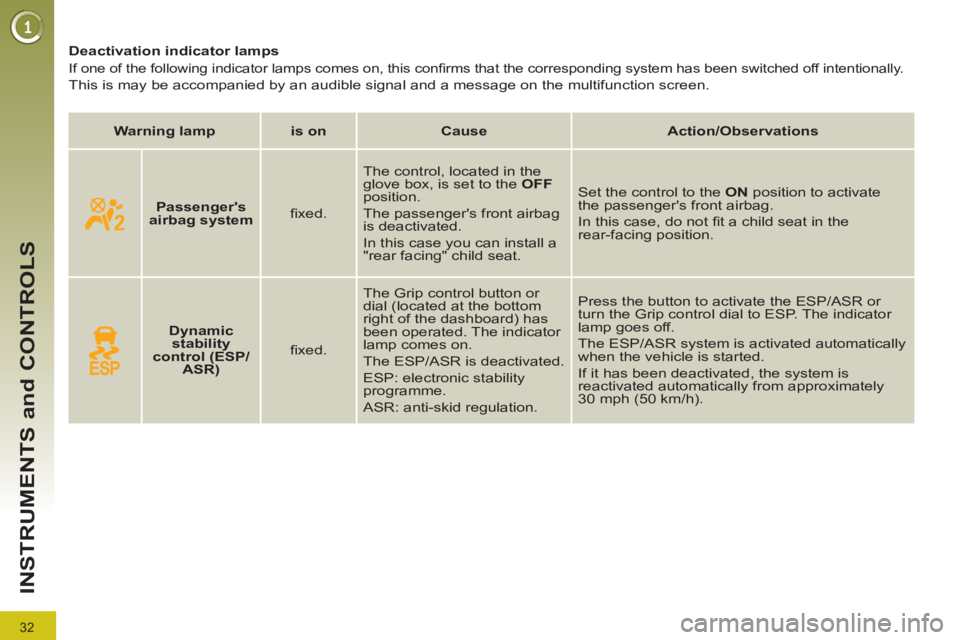
32
INSTRUMENTS and CONTROLS
Deactivation indicator lamps
If one of the following indicator lamps comes on, this confi rms that the corresponding system has been switched off intentionally.
This is may be accompanied by an audible signal and a message on the multifunction screen.
Warning lamp
is on
Cause
Action/Observations
Passenger's
airbag system
fi xed. The control, located in the
glove box, is set to the OFF
position.
The passenger's front airbag
is deactivated.
In this case you can install a
"rear facing" child seat. Set the control to the ON
position to activate
the passenger's front airbag.
In this case, do not fi t a child seat in the
rear-facing position.
Dynamic
stability
control (ESP/
ASR)
fi xed. The Grip control button or
dial (located at the bottom
right of the dashboard) has
been operated. The indicator
lamp comes on.
The ESP/ASR is deactivated.
ESP: electronic stability
programme.
ASR: anti-skid regulation. Press the button to activate the ESP/ASR or
turn the Grip control dial to ESP. The indicator
lamp goes off.
The ESP/ASR system is activated automatically
when the vehicle is started.
If it has been deactivated, the system is
reactivated automatically from approximately
30 mph (50 km/h).
Page 115 of 328
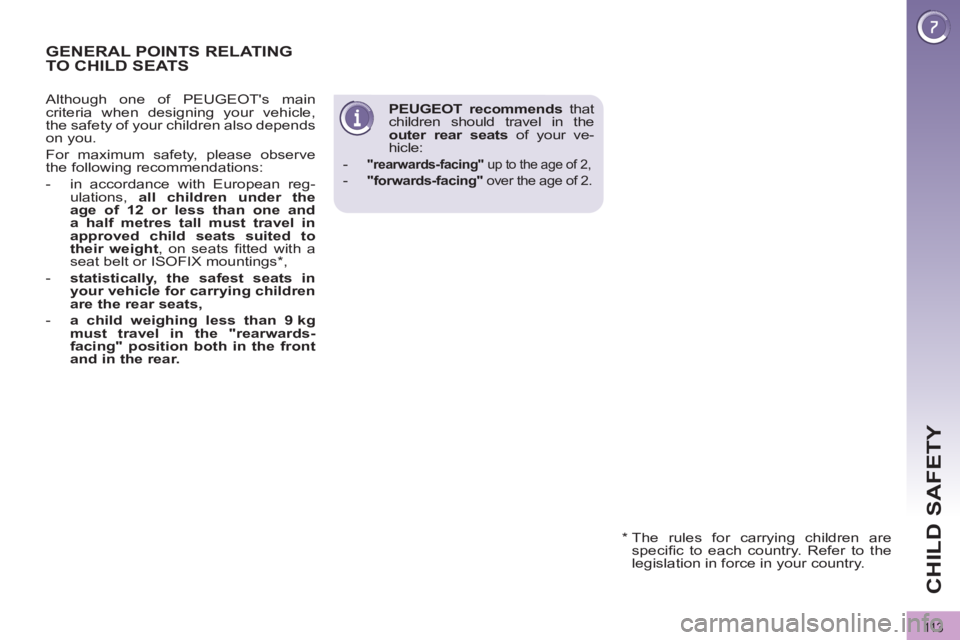
11 3
CHILD SAFETY
PEUGEOT recommends
that
children should travel in the
outer
rear seats
of your ve-
hicle:
-
"rearwards-facing"
up to the age of 2,
- "forwards-facing"
over the age of 2.
GENERAL POINTS RELATING
TO CHILD SEATS
*
The rules for carrying children are
specifi c to each country. Refer to the
legislation in force in your country. Although one of PEUGEOT's main
criteria when designing your vehicle,
the safety of your children also depends
on you.
For maximum safety, please observe
the following recommendations:
- in accordance with European reg-
ulations, all children under the
age of 12 or less than one and
a half metres tall must travel in
approved child seats suited to
their weight
, on seats fi tted with a
seat belt or ISOFIX mountings * ,
- statistically, the safest seats in
your vehicle for carrying children
are the rear seats,
- a child weighing less than 9 kg
must travel in the "rearwards-
facing" position both in the front
and in the rear.
Page 116 of 328
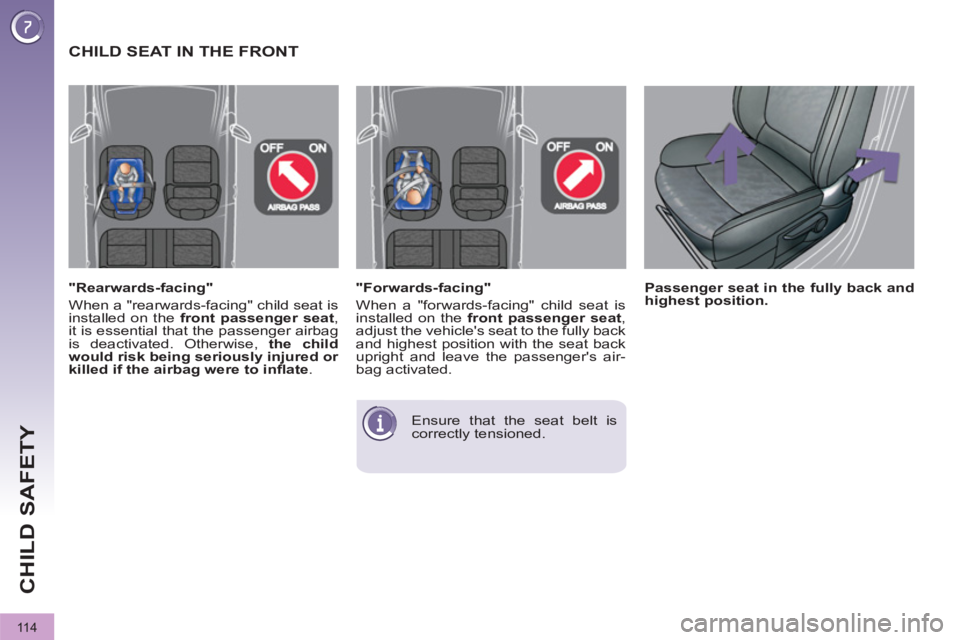
11 4
CHILD SAFETY
"Forwards-facing"
When a "forwards-facing" child seat is
installed on the front passenger seat
,
adjust the vehicle's seat to the fully back
and highest position with the seat back
upright and leave the passenger's air-
bag activated.
Ensure that the seat belt is
correctly tensioned.
Passenger seat in the fully back and
highest position.
"Rearwards-facing"
When a "rearwards-facing" child seat is
installed on the front passenger seat
,
it is essential that the passenger airbag
is deactivated. Otherwise, the child
would risk being seriously injured or
killed if the airbag were to infl ate
.
CHILD SEAT IN THE FRONT
Page 117 of 328
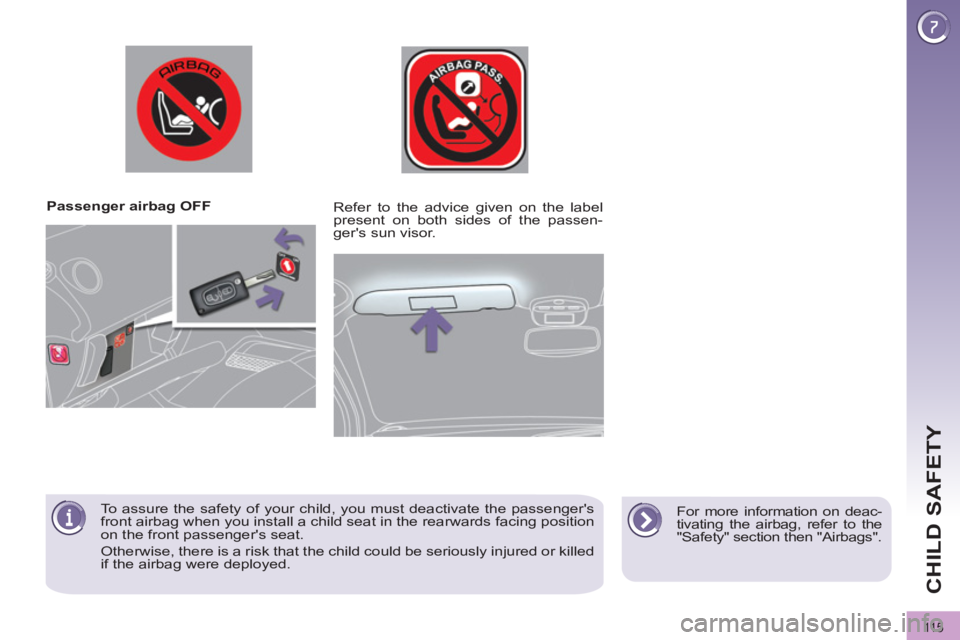
11 5
CHILD SAFETY
Passenger airbag OFF
For more information on deac-
tivating the airbag, refer to the
"Safety" section then "Airbags".
Refer to the advice given on the label
present on both sides of the passen-
ger's sun visor.
To assure the safety of your child, you must deactivate the passenger's
front airbag when you install a child seat in the rearwards facing position
on the front passenger's seat.
Otherwise, there is a risk that the child could be seriously injured or killed
if the airbag were deployed.
Page 118 of 328
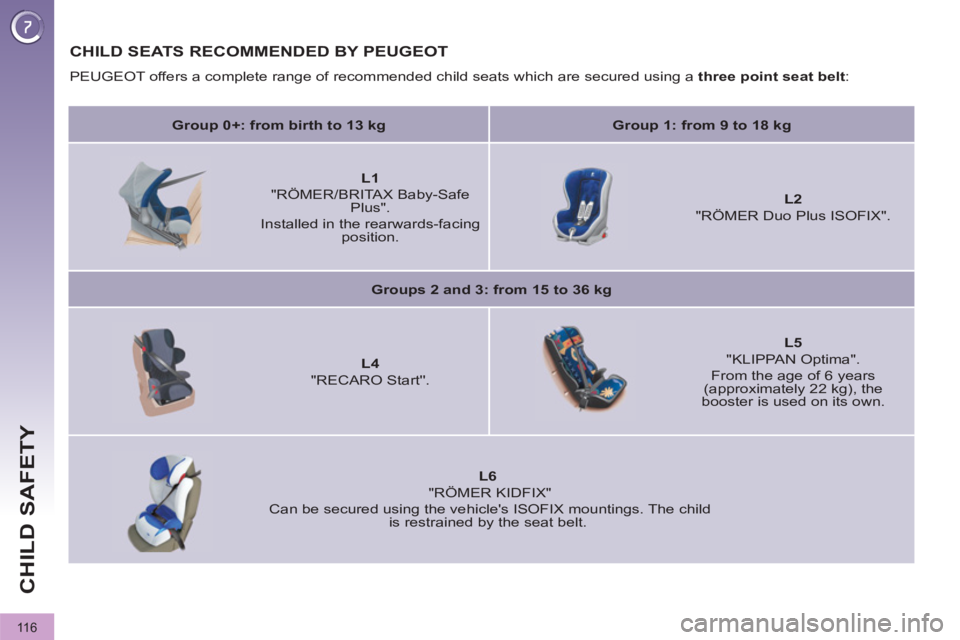
11 6
CHILD SAFETY
CHILD SEATS RECOMMENDED BY PEUGEOT
PEUGEOT offers a complete range of recommended child seats which are secured using a three point seat belt
:
Group 0+: from birth to 13 kg
Group 1: from 9 to 18 kg
L1
"RÖMER/BRITAX Baby-Safe
Plus".
Installed in the rearwards-facing
position.
L2
"RÖMER Duo Plus ISOFIX".
Groups 2 and 3: from 15 to 36 kg
L4
"RECARO Start''.
L5
"KLIPPAN Optima".
From the age of 6 years
(approximately 22 kg), the
booster is used on its own.
L6
"RÖMER KIDFIX"
Can be secured using the vehicle's ISOFIX mountings. The child
is restrained by the seat belt.
Page 119 of 328
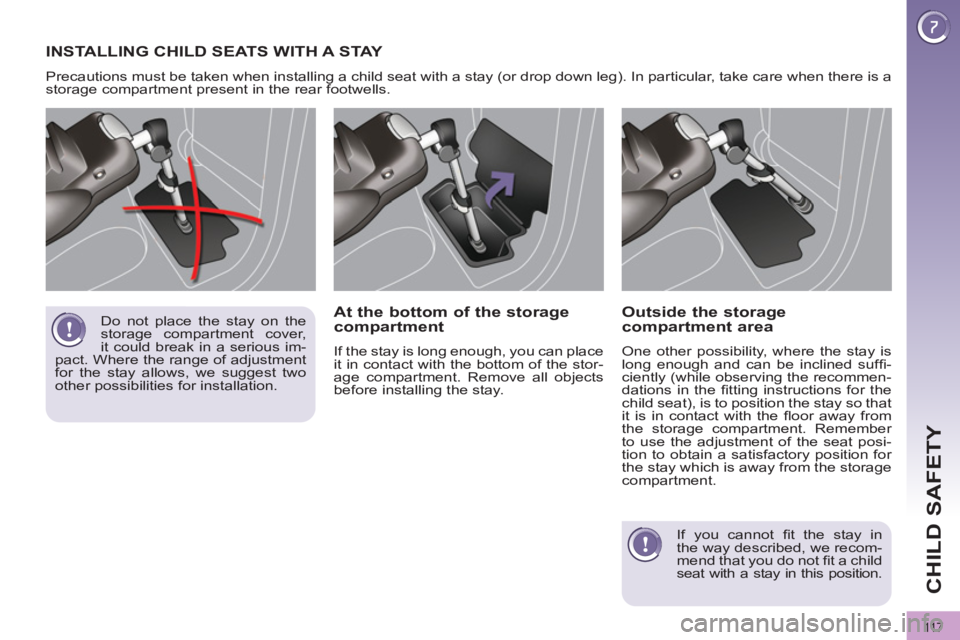
11 7
CHILD SAFETY
INSTALLING CHILD SEATS WITH A STAY
Precautions must be taken when installing a child seat with a stay (or drop down leg). In particular, take care when there is a
storage compartment present in the rear footwells.
Do not place the stay on the
storage compartment cover,
it could break in a serious im-
pact. Where the range of adjustment
for the stay allows, we suggest two
other possibilities for installation.
At the bottom of the storage
compartment
If the stay is long enough, you can place
it in contact with the bottom of the stor-
age compartment. Remove all objects
before installing the stay.
Outside the storage
compartment area
One other possibility, where the stay is
long enough and can be inclined suffi -
ciently (while observing the recommen-
dations in the fi tting instructions for the
child seat), is to position the stay so that
it is in contact with the fl oor away from
the storage compartment. Remember
to use the adjustment of the seat posi-
tion to obtain a satisfactory position for
the stay which is away from the storage
compartment.
If you cannot fi t the stay in
the way described, we recom-
mend that you do not fi t a child
seat with a stay in this position.
Page 120 of 328
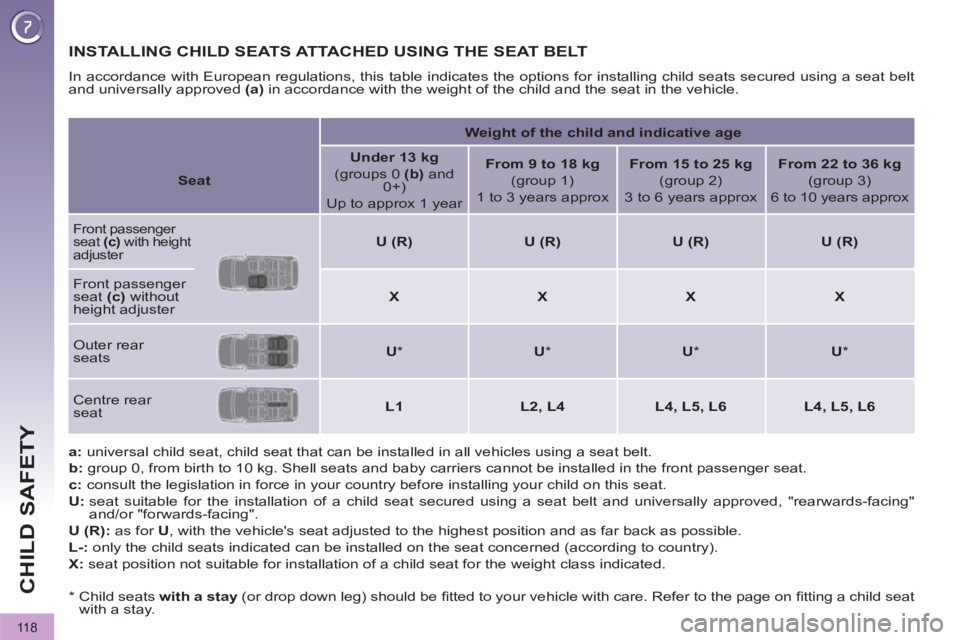
11 8
CHILD SAFETY
INSTALLING CHILD SEATS ATTACHED USING THE SEAT BELT
In accordance with European regulations, this table indicates the options for installing child seats secured using a seat belt
and universally approved (a)
in accordance with the weight of the child and the seat in the vehicle.
a:
universal child seat, child seat that can be installed in all vehicles using a seat belt.
b:
group 0, from birth to 10 kg. Shell seats and baby carriers cannot be installed in the front passenger seat.
c:
consult the legislation in force in your country before installing your child on this seat.
U:
seat suitable for the installation of a child seat secured using a seat belt and universally approved, "rearwards-facing"
and/or "forwards-facing".
U (R):
as for U
, with the vehicle's seat adjusted to the highest position and as far back as possible.
L-:
only the child seats indicated can be installed on the seat concerned (according to country).
X:
seat position not suitable for installation of a child seat for the weight class indicated.
Weight of the child and indicative age
Seat
Under 13 kg
(groups 0 (b)
and
0+)
Up to approx 1 year
From 9 to 18 kg
(group 1)
1 to 3 years approx
From 15 to 25 kg
(group 2)
3 to 6 years approx
From 22 to 36 kg
(group 3)
6 to 10 years approx
Front passenger
seat (c)
with height
adjuster
U (R)
U (R)
U (R)
U (R)
Front passenger
seat (c)
without
height adjuster
X
X
X
X
Outer rear
seats
U
*
U
*
U
*
U
*
Centre rear
seat
L1
L2, L4
L4, L5, L6
L4, L5, L6
*
Child seats with a
stay
(or drop down leg) should be fi tted to your vehicle with care. Refer to the page on fi tting a child seat
with a stay.
Page 121 of 328
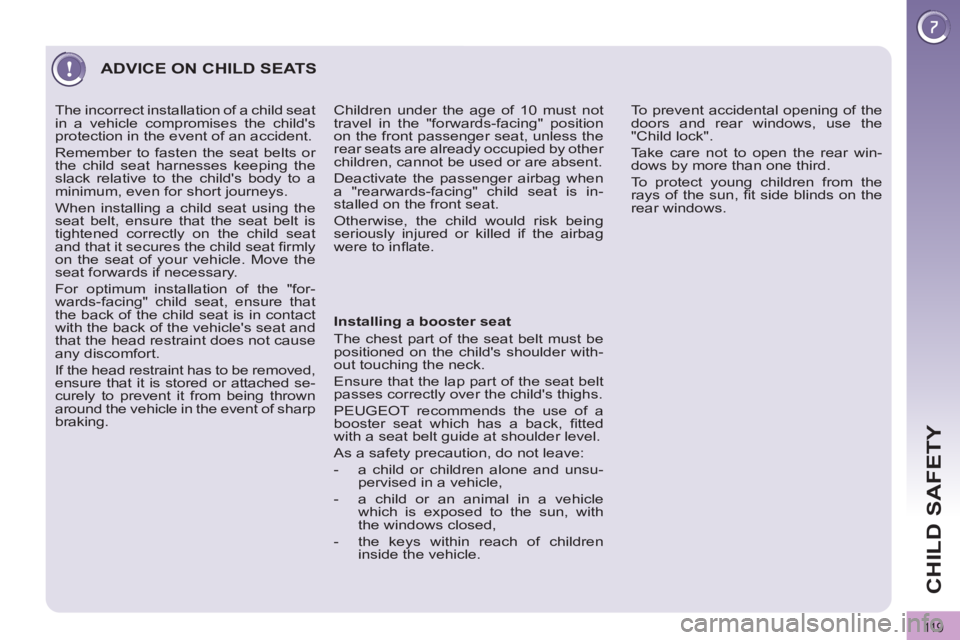
11 9
CHILD SAFETY
ADVICE ON CHILD SEATS
Installing a booster seat
The chest part of the seat belt must be
positioned on the child's shoulder with-
out touching the neck.
Ensure that the lap part of the seat belt
passes correctly over the child's thighs.
PEUGEOT recommends the use of a
booster seat which has a back, fi tted
with a seat belt guide at shoulder level.
As a safety precaution, do not leave:
- a child or children alone and unsu-
pervised in a vehicle,
- a child or an animal in a vehicle
which is exposed to the sun, with
the windows closed,
- the keys within reach of children
inside the vehicle. To prevent accidental opening of the
doors and rear windows, use the
"Child lock".
Take care not to open the rear win-
dows by more than one third.
To protect young children from the
rays of the sun, fi t side blinds on the
rear windows.
Children under the age of 10 must not
travel in the "forwards-facing" position
on the front passenger seat, unless the
rear seats are already occupied by other
children, cannot be used or are absent.
Deactivate the passenger airbag when
a "rearwards-facing" child seat is in-
stalled on the front seat.
Otherwise, the child would risk being
seriously injured or killed if the airbag
were to infl ate. The incorrect installation of a child seat
in a vehicle compromises the child's
protection in the event of an accident.
Remember to fasten the seat belts or
the child seat harnesses keeping the
slack relative to the child's body to a
minimum, even for short journeys.
When installing a child seat using the
seat belt, ensure that the seat belt is
tightened correctly on the child seat
and that it secures the child seat fi rmly
on the seat of your vehicle. Move the
seat forwards if necessary.
For optimum installation of the "for-
wards-facing" child seat, ensure that
the back of the child seat is in contact
with the back of the vehicle's seat and
that the head restraint does not cause
any discomfort.
If the head restraint has to be removed,
ensure that it is stored or attached se-
curely to prevent it from being thrown
around the vehicle in the event of sharp
braking.